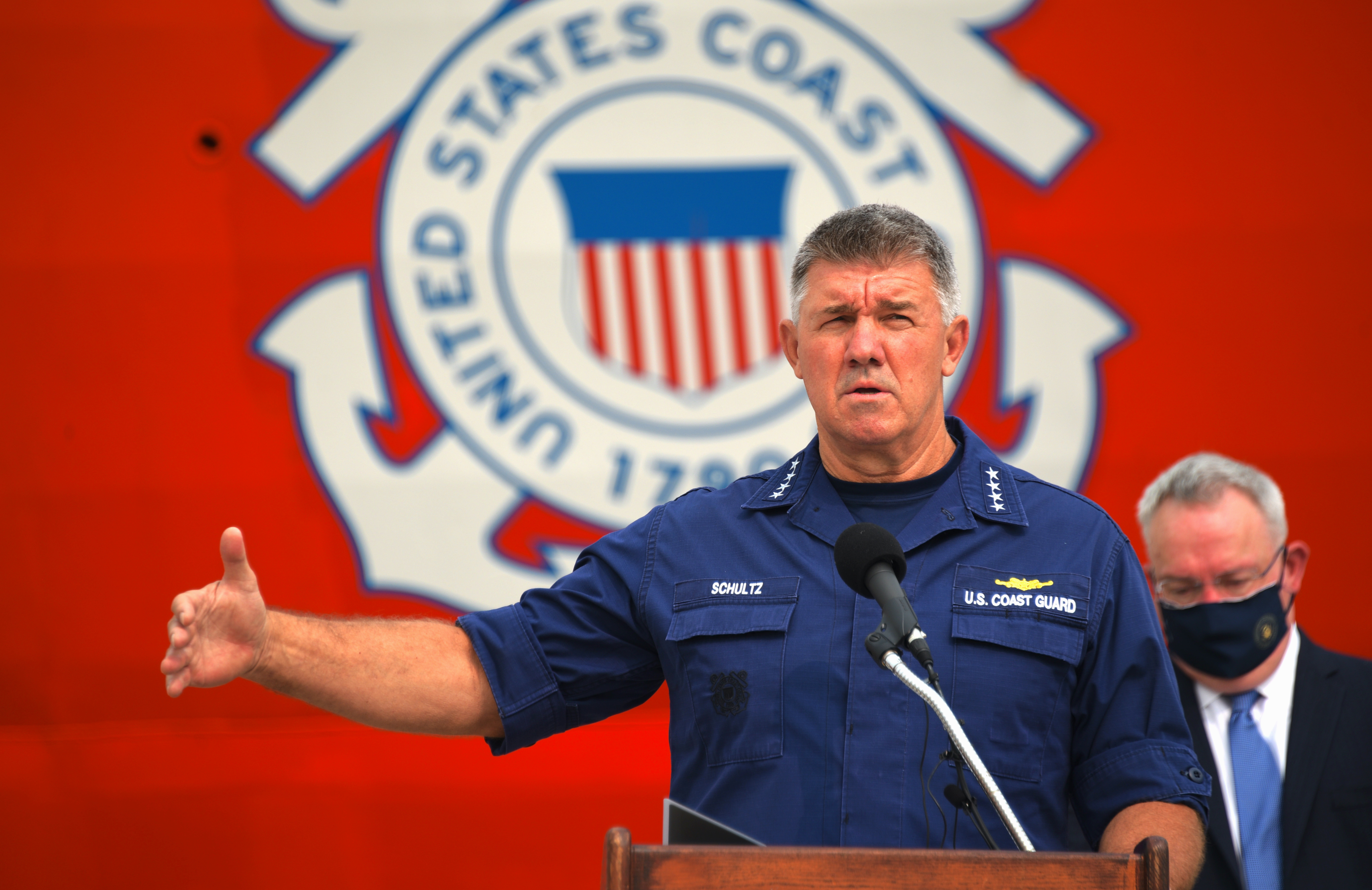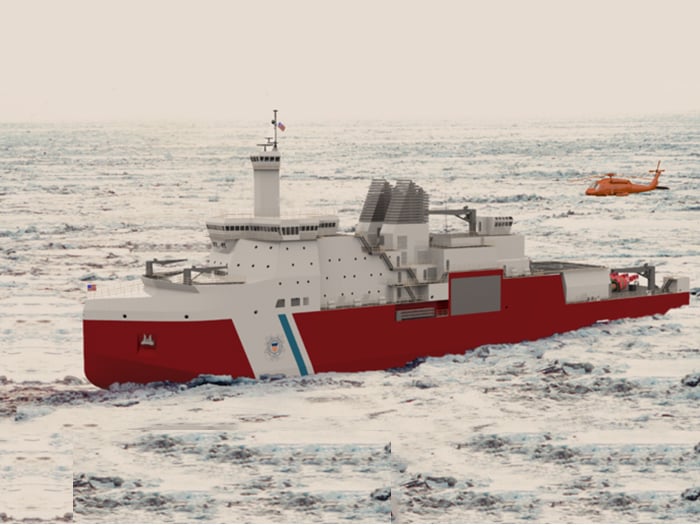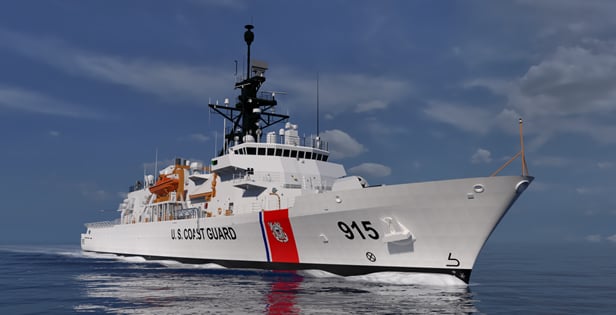
The Coast Guard commandant said “readiness remains foremost” on his mind, with an emphasis on “dollars for people,” in the coming budget that is being developed in the midst of an administration change.
Using child care as an example, Adm. Karl Schultz said it was unlikely that the service would be able to provide child care centers for its members and their families scattered across 350 locations in the country, but an allowance to reflect the cost of living in a particular area for child care “would drive down out-of-pocket expenses” these families face.
Speaking Thursday at a Navy League event, the commandant also said he wants to “build out the workforce” while “maintaining the momentum” on its five shipbuilding programs.
Schultz also wants more funds available to invest in information technology and cyber. He added the Coast Guard, unlike much of the Defense Department, has switched over to Microsoft Office 365 for basic office operations to improve efficiency there. Schultz described previous efforts at improving IT for internal operations, like personnel management and cyber capabilities for port security and cargo inspection, to a Mr. Potato Head: features are added on to the figure, but a serious overhaul is never made.
Schultz also said modernizing cyber and expanding the use unmanned vessels and aircraft were especially important in remaining interoperable with the Navy and the Marine Corps. He cited operations in the Eastern Atlantic and the Caribbean as an example of increased Navy-Coast Guard integration in countering drug-smuggling. In that light, he said a new integrated maritime strategy will be published soon. “It’s really a great document” that defines roles.
Unlike the Pentagon, whose budget has risen 23 percent since 2018, Schultz said the Coast Guard’s has only grown by 7 percent in the same time.
Being in the Department of Homeland Security, “we were not part of that 2018 bump” that went to the Pentagon. He added, “we’ve been scratching and clawing” since to find money for readiness, modernization and personnel.
When asked about the possibility of a federal government shutdown Dec. 11, Schultz said that, in his judgment, the probability was low; but if it happens, “we can pay our people for a period or two.”
When the government shut down for 35 days shortly before Christmas 2018, DoD service members were exempted and continued to be paid. Coast Guard personnel – uniform and “excepted civilians” – continued to work without pay in January, causing financial hardships.
Although there have been bills introduced to pay Coast Guard members during a shutdown, just like those serving in the Defense Department are paid, “we have not got that over the goal line.”
Schultz went a step further, saying that for 30 to 40 percent of the time since he became commandant two years ago DHS has been operating under continuing resolutions, which hold spending to previous year levels and restricts spending on new programs.
With CRs, “it is very hard to control shipyard work” for repairs and modernization, which often span from one fiscal year into the next and require consistent funding. Commercial yards want the guaranteed contract to extend until the work is completed as estimated. Schultz said the Coast Guard has received some relief in this area by allowing it to project out for two years.
On the cutter modernization programs, Schultz reported “good news” on congressional support.
 “There’s been conversation” in the administration and with Congress about expanding upon his plan for to have six icebreakers in the fleet to meet missions in the polar regions.
“There’s been conversation” in the administration and with Congress about expanding upon his plan for to have six icebreakers in the fleet to meet missions in the polar regions.
One way suggested to increase the number of American icebreakers is to lease them, but “we clearly don’t want to do that” over the long term. He added leasing “might be possible for bridging” until the Coast Guard could build more of its own.
“There’s some goodness coming out of that” discussion over what the nation needs for operations in the Arctic and Antarctic.
The Coast Guard’s plan is to have six icebreakers: three heavy, which are now designated as Polar Security Cutters, and three medium.
“Steel-cutting will begin early next year” on the first Polar Security Cutter at VT Halter Marine in Pascagoula, Miss. Although the Fiscal Year 2021 budget has yet to clear Congress, Schultz added there was $555 million for the second heavy icebreaker in the request, as well an acquisition and funding strategy for the third.
Schultz noted interest in “high-latitude operations” is receiving bipartisan support on Capitol Hill.
On the service’s number-one acquisition priority, the Offshore Patrol Cutter, Schultz said, “we’re out of the gate and off to the races” as the keel for lead ship Argus (WMSM-915) was laid at the Eastern Shipbuilding Group’s facility in Panama City, Fla., this spring. It is expected to be delivered in 2022. He noted that the Coast Guard has signed a modified contract with Eastern to begin construction on Chase for delivery in 2023, as well as one to buy the long-lead material necessary for the fourth ship in the class. Eastern was awarded a contract for engines on the third, Ingham, also in the spring.

Hurricane Michael in 2018 dealt a serious blow to the original construction schedule and to Eastern’s facilities. The damage was so extensive and the loss of workforce potentially so great that it caused the Coast Guard to re-compete the program. Argus was originally to be delivered next year. He called this class of cutter “really the backbone” of Coast Guard missions. It fills the “middle space” between the National Security Cutter and the Fast Response Cutter.
To the crews of the existing 210-foot Reliance class cutters, he said, “help is on the way” as this new program is built and delivers to the fleet.
“The goal is to build 25” Offshore Patrol Cutters, necessary for a recapitalized fleet that extends to from the Polar Security Cutters and National Security Cutters to waterways vessels. Schultz said requests for proposals for three variants of the waterways vessels will be published soon.
On operations, Schultz said the Coast Guard is receiving “pulsing signals” from U.S. Indo-Pacific Command about the need and value of the new Fast Response Cutters for partnership operations in Oceania to help monitor illegal fishing in those waters.
Likewise, Ecuador, through U.S. Southern Command, wanted Coast Guard assistance to check on the activities of 350 Chinese vessels fishing in the restricted waters off the Galapagos Marine Reserve, about 1,000 miles off the its coast. He said the service’s ScanEagle, a small, long-range, low-altitude unmanned aerial vehicle, played a key role in inspecting suspicious activities.





